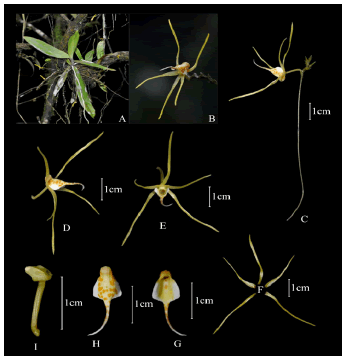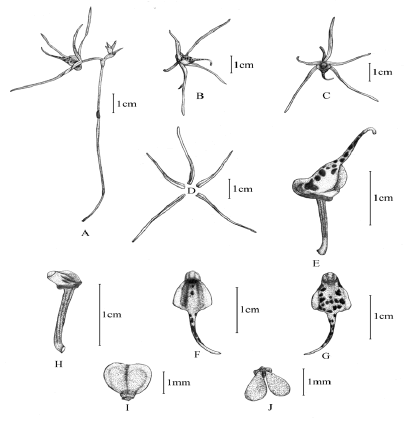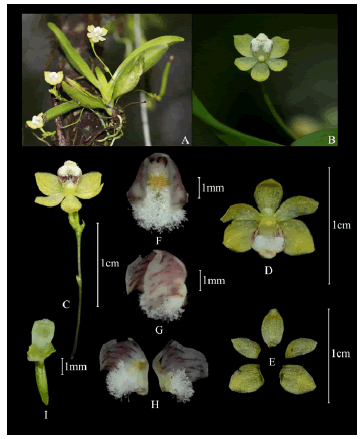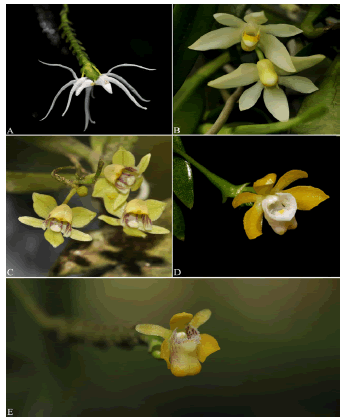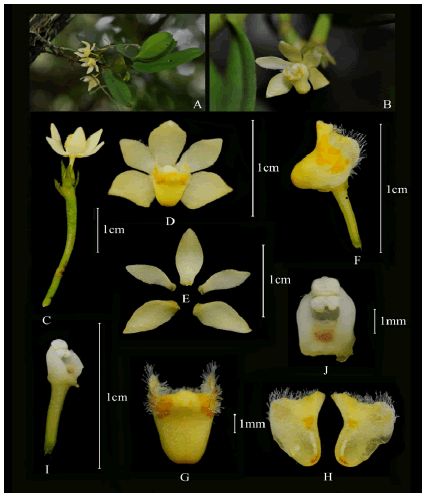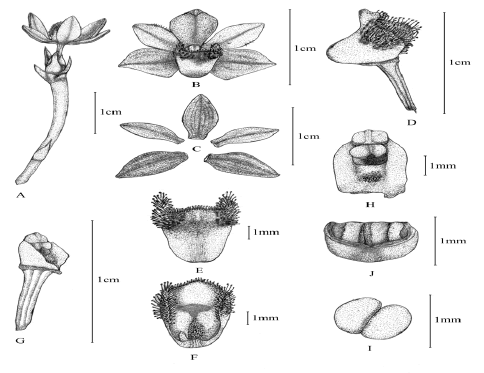Research Article - Modern Phytomorphology ( 2022) Volume 16, Issue 5
The genus Thrixspermum Loureiro in Arunachal Pradesh and three new additions
Khyanjeet Gogoi and K. Chowlu*K. Chowlu, Botanical Survey of India, Arunachal Pradesh Regional Centre Senki View, Itanagar, Arunachal Pradesh- 791111, India, Email: krishnachowlu@gmail.com
Received: 01-Sep-2022, Manuscript No. mp-22- 75364; Accepted: 23-Sep-2022, Pre QC No. mp-22- 75364(PQ); Editor assigned: 03-Sep-2022, Pre QC No. mp-22- 75364(PQ); Reviewed: 05-Sep-2022, QC No. mp-22- 75364(Q); Revised: 17-Sep-2022, Manuscript No. mp-22- 75364(R); Published: 05-Oct-2022
Abstract
Among the Orchid flora of Arunachal Pradesh, 9 species of Thrixspermum were recorded in an intensive field survey during 2014- 2022 covering all the geographical areas of the state. T. acuminatissimum, T. merguense and T. trichoglottis are described and illustrated with detailed photos and line drawings; has been added to the orchid flora of Arunachal from Trirap district
Keywords
Orchid species, Status, Diversity resources, Distribution.
Introduction
The genus Thrixspermum is described by Joao de Loureiro (1790: 519) by its plant habit with lateral, axillary or racemose inflorescence, few to many flowered; floral bracts distichous; flowers half or fully opened, small to medium-sized, variable in size; sepals and petals sub equal; short column with a broad foot, a callus on the front of the sac on the lip and four unequal pollinia jointed by a stipe. It is represented by 191 (POWO 2022; K. Gogoi 2022) species in the world, distributed from the Himalayas to the Philippines and tropical Islands to S.W. Pacific (Govaertset al. 2022). This genus is represented by 17 (Maina et al. 1998; Misra 2019; Mao et al. 2011; Gogoi & Yonzone 2015; Vikas Kumar et al. 2017; Gogoi 2011, 2018a, 2018b, 2019a, 2019b, 2022) species in India and in Arunachal Pradesh it is represented by 6species viz., T. centipede Loureiro (1790: 520); T. changlangensis K. Gogoi (2019: 167); Thrixspermum japonicum (Miquel) Reichenbach f. (1878: 75); T. musciflorum A.S. Rao & J. Joseph; T. patkaiensisK. Gogoi; T. saruwatarii (Hayata) Schlechter (1919: 275), and with the addition of 3 species viz., T. acuminatissimum (Blume) Reichenbach f. (1867: 121); T. merguense (Hooker f.) Kuntze (1891: 682) and Thrixspermum trichoglottis (Hooker f.) Kuntze (1891: 682) the number used to be 9 species.
In Trirap district of Arunachal Pradesh, during a field visit to the Hukanjuri area in 2019 by the authors, a few species of Thrixspermum were collected at a tropical altitude in vegetative condition and planted in the Regional Orchid Germplasm Conservation and Propagation Centre (Assam Circle) for flowering. Later, after flowering, it was identified by consultation of available literature(Seidenfaden 1975; Chowdhery 1998, 2009; King & Pantling 1898; Pearce & Cribb 2002; Pradhan 1997; Lucksom 2007; Chen et al. 2009; Rao 2010; Gogoi &Yonzone2015; Hegde 2017; Gogoi 2018 a, 2019a, 2022; Singh et al. 2019) and consultation of herbaria as T. acuminatissimum; T. merguense and T. trichoglottis which are new to the state. A detailed description, illustration, and information on habitat and geographic distribution have been provided in the present manuscript to facilitate the field botanists to locate it in other parts of the N.E. Indian region. The voucher specimen has been deposited at the Herbarium of The Orchid Society of Eastern Himalaya (TOSEHIM), Regional Orchid Germplasm Conservation and Propagation Centre (Assam Circle), Assam.
Taxonomic treatment
Thrixspermum acuminatissimum (Blume) Reichenbachf. Xenia Orchidacea.2: 121, 1867; Scidenfadenet al, Orchid of Thiland, iv-I, 518, 1962. Sarcochilus notabilis Hooker f., Flora of British India, 6: 42, 1890.Dendrocolla acuminatissima Blume, Bijdragen tot de flora van Nederlandsch Indie, 286, 1825. Aerides acuminatissimum (Blume) Lindley, Genera and Species of Orchidaceous Plants, 240, 1833.Sarcochilus acuminatissimus (Blume) Reichenbach f., Annales Botanices Systematicae, 6: 498, 1863. Thrixspermum notabile (Hooker f.) Kuntze, RevisioGenerum Plantarum, 2: 682, 1891. Ridleya notabilis (Hooker f.) Pfitzer, Naturlichen Pflanzenfamilien. Nachtrage, 2: 16, 1900. Worldwide, the area sown to millet has remained relatively stable at around 38 million hectares for the past two decades. Both production and yield increased by a little over 10 percent through the 1980s, but have remained unchanged since then. Current global production is about 28 million tons, and average yields are 0.75 t/ ha. At a regional level, however, there are sharp differences in trends, especially between the two main producers, Asia and Africa.
Specimen examined: India, Arunachal Pradesh, Trirap district, Hukanjuri, dated 19. 04. 2019. Gogoi & Chowlu 00813 (TOSEHIM). Epiphytic; stem very short, 1–2 cm long; leaves distichous, 3.5–5× 1–1.5 cm, subsessile, bilobed at apex, articulated to sheathing leaf base, coriaceous, oblong; peduncles 3 or more, arising from one point on the stem, 10–12 cm long, curved, naked; raceme 5–6.5 cm, bracts ovate, incurved coriaceous, subacute; pedicel and ovary very slender, 0.7 cm long; flowers yellow, odourless; sepals and petals yellow, filiform, membranous, 2–2.5 cm long, narrowly lanceolate, linear-oblong, acuminate, 3 nerved at the base; lip with a large sac rounded at the base, white with yellow and reddish-brown spots, apex white, delicately veined, contracted into a capillary tail; column light yellow, deeply saccate, footless, very short; pollinia 2, light yellow, membranous, clavate, sessile on a rather large gland.
Flowering: July–November. Habitat: Growing on lateral branches of lower canopy of host tree, cool and shady place in tropical mixed ev¬ergreen forest. Distribution: India (Arunachal Pradesh, Assam), Malaysia, Myanmar.Status: Rare. The species was found only in one locality.
Thrixspermum centipede Loureiro, Flora Cochinchinensis. 520. 1790. Thrixspermum papillosum Carr, The Gardens' bulletin; Straits Settlements 5: 33. 1929. Thrixspermum arachnites (Blume) Reichenbach f. Xenia Orchidacea. 2: 121. 1868. Dendrocolla arachnites Blume, Bijdragen tot de flora van Nederlandsch Indië.287. 1825(Fig. 1).
Specimen examined: Arunachal Pradesh, Itanagar, Chimpu River, Chowlu 40085 (ARUN); Madhuban, Rao-28334 (Orchid Herbarium Tippi); Seijusa, Hegde-12202; Madhuban, Rao-28055; (Orchid Herbarium Tippi)
Flowering: June–July. Habitat: Growing on lateral branches of lower canopy of host tree, cool and shady place in tropical mixed ev¬ergreen forest. Distribution: India (Arunachal Pradesh, Assam, Manipur, Meghalaya, Mizoram, Sikkim, West Bengal), Australia, Bangladesh, China, IndoÃÃÂ???China, Indonesia, Malaysia, Myanmar, Thailand. Status: Common; very common in tropical for A & B. habit; C. inflorescence; D.lateral view of flower; E. ventral view of flower; F. perigone; G. ventral view of lip; H. dorsal view of lip; I. ovary and column with the foot. Photo by Khyanjeet Gogoi.
Figure 1: Thrixspermum acuminatissimum
A inflorescence; B.lateral view of flower; C. ventral view offlower; D. perigone; E. lateral view of lip, column, and ovary, F. ventral view of lip; G. dorsal view of lip; H. ovary and column with the foot; I. dorsal viewof anther cap with pollinia;J. pollinia. Drawn by Khyanjeet Gogoi.
Figure 2: Thrixspermum acuminatissimum.
A. inflorescence; B. ventral view of flower; C. ventral view of perigone; D. dorsal view of perigone; E. lip, column, and ovary;F. ventral view oflip; G. lateral view of lip; H. dorsal view of lip; I. ovary and column with the foot; J. column. Drawn by Khyanjeet Gogoi.
Figure 3: Thrixspermum merguense.
A & B. habit; C. inflorescence; D.ventral view of flower; E. perigone; F. ventral view of lip; G. lateral view of lip; H.longitudinal section of lip; I. ovary and column with the foot. Photo by Khyanjeet Gogoi (Fig. 2,3).
A.Thrixspermum centipeda, B. Thrixspermum changlangensis, C. Thrixspermum japonicum, D.Thrixspermum musciflorum, E.Thrixspermum pathaiensis.
Thrixspermum changlangensis K. Gogoi, Pleione 13(1): 167ÃÃÂ???170. 2019.
Specimen examined: India, Arunachal Pradesh, Changlang district, Nampong, Khyanjeet Gogoi 00802 [Holo 00802 A (ASSAM); Iso 00802 B, (DU); Iso 00802 C, (TOSEHIM) (The Orchid Society of Eastern Himalaya).
Flowering: May–June. Habitat: Epiphytic on trees or branches in tropical mixed ev¬ergreen forest. Distribution: India (Arunachal Pradesh) endemic. Status: Rare; the species was found only in one locality.
Thrixspermum japonicum (Miquel) Reichenbach f., Botanische Zeitung (Berlin) 36: 75. 1878. Sarcochilus japonicusMiquel, Annales Musei Botanici Lugduno-Batavi. 2: 206. 1866.
Specimen examined: India, Arunachal Pradesh, Ziro Valley, Gogoi – 00804, (TOSEHIM) (The Orchid Society of Eastern Himalaya).
Flowering: September–October. Habitat: Epiphytic on trees or branches, growing on the twigs and small branches of Pine trees. Distribution: India (Ziro, Arunachal Pradesh), Bhutan, China, Korea and southern Japan. Status: Rare; the species was found only in one locality.
Thrixspermum merguense (Hooker f.) Kuntze, RevisioGenerum Plantarum, 2: 682. 1891.Sarcochilus merguensis Hooker f., Flora of British India, 6: 40. 1890. Dendrocolla merguensis (Hooker.f.) Ridley, Journal of the Linnean Society. Botany, 32: 380.1896. Thrixspermum comans J.J. Smith, Bulletin De Department De L'Agriculture Aux Indes Neerlandaises. 13: 61.1907. Thrixspermum bicristatum Ames, Orchidaceae 5: 202.1915. SarcochiluskusukusensisHayata, Icones Plantarum Formosanarum. 6: 83.1916. Thrixspermum kusukusense (Hayata) Schlechter, Repertorium Specierum Novarum Regni Vegetabilis, Beihefte. 4: 274.1919. Thrixspermum comans var. bicristatum (Ames) L.O.Williams, Botanical Museum Leaflets. 6: 80.1938. Ascochilus pulvinatus Guillaumin, Bulletin du Muséum National d'Histoire Naturelle, series 2, 36: 539.1965.
Specimen examined: India, Arunachal Pradesh, Trirap district, Hukanjuri, dated 19.04.2019. Gogoi & Chowlu 00812 (TOSEHIM) (Fig. 4&5). Plant epiphytic herb. Stem with several leaves. Leaves oblong or oblongÃÃÂ???narrowly elliptic, obtuse at apex, slightly bilobed, sheathing at base. Inflorescence 3–5 cm long, few-flowered; rachis slightly thickened; floral bracts broadly lanceolate, acute at apex. Flowers pale yellowish green with purple boundaries in the lip, contiguous. Dorsal sepal 0.4–0.5 × 0.2–0.3 cm, oblong or ovateÃÃÂ???oblong, acute at apex; laterals broadly elliptic, acute at apex. Petals ovateÃÃÂ???oblong, acute at apex. Lip 0.3–0.4 ×0.4–0.5 cm, triangular, white with light purple linings, 3 lobed; lateral lobes erect; mid lobe truncate; disc with 2 calli, tufts with hairs. Column short, 0.2 cm long.
Figure 4: Thrixspermum merguense
Figure 5: Thrixspermum species of Arunachal Pradesh.
Flowering: July–November. Habitat: Epiphytic on tree-main trunks or branches in tropical mixed ev¬ergreen forest. Distribution: India (Arunachal Pradesh, Assam, Andaman & Nicobar Island), China, IndoÃÃÂ???China, Indonesia, Malaysia, Myanmar, Phillippines, Thailand. Status: Rare; the species was found only in one locality.
Thrixspermum musciflorum A.S. Rao & J. Joseph, Bulletin of Botanical Survey of India11: 204. 1971. Thrixspermum musciflorum var. nilagiricum J. Joseph & Vajr., Indian Forester 107: 648. 1981.
Specimen examined: Arunachal Pradesh, Namorah, 17.12.79. Hegde 2797; (Orchid Herbarium Tippi).
Flowering: May– June. Habitat:Epiphytic on tree trunks in tropical mixed ev¬ergreen forest. Distribution: India (Arunachal Pradesh, Assam, Manipur, Meghalaya, Sikkim, Kerala, Tamil Nadu), endemic.Status: Rare; distribution restricted in some particular areas.
Thrixspermum patkaiensis K. Gogoi, Lankesteriana 22(1): 9.16.2022.
Specimen examined: INDIA, Arunachal Pradesh, Changlang district, Hukanjuri, 200m, K. Gogoi &Chowlu 41506 (ARUN); Assam, Tinsukia district, K. Gogoi 00956 (TOSEHIM).
Flowering: May–October.Habitat:Epiphytic on tree trunks in tropical mixed ev¬ergreen forest.Distribution. India (Arunachal Pradesh, Assam) endemic.Status: Rare; the species was found only in a fewlocalities.
Thrixspermum saruwatarii (Hayata) Schlechter, Repertorium Specierum Novarum Regni Vegetabilis. Beiheft. 4: 275. 1919. Sarcochilus saruwatarii Hayata, Icones Plantarum Formosanarum, 6: 81. 1916.
Specimen examined: India, Arunachal Pradesh, West Siang, Lharlung village near Mechuka 2020 m, 5.05.2011, Ona Apang 49362, 49363 (Orchid Herbarium Tippi); Mao & Bhaumik 25640 A,B,C (ARUN), MechukaÃÃÂ???Yorko, 1900 m, Bhaumik 25068 AÃÃÂ???B (ARUN).
Flowering: May–June. Habitat: Epiphytic on tree trunks. Distribution. India (Arunachal Pradesh), Taiwan. Status: Rare; distribution restricted in some particular areas.
Thrixspermum trichoglottis (Hooker f.) Kuntze, Revisio Generum Plantarum 2: 682. 1891. Sarcochilus trichoglottis Hooker f., Flora of British. India 6: 39. 1890. Dendrocolla trichoglottis (Hooker f.) Ridley, Journal of the Linnean Society. Botany.32: 381. 1896. Dendrocolla albaRidley, Journal of the Straits Branch of the Royal Asiatic Society44: 191. 1905. Thrixspermum album (Ridley) Schlechter, Orchis 5: 56. 1911.
Specimen examined: India, Arunachal Pradesh, Trirap district, Hukanjuri, dated 19.04.2019. Gogoi & Chowlu 00814 (TOSEHIM) (Fig. 6&7).
Figure 6: Thrixspermum trichoglottis.
Figure 7: Thrixspermum trichoglottis.
Stems 3–7 cm long, with several nodes, many leaved. Leaves 3–5.5 × 0.5–1 cm, leathery, obtuse and slightly unequally bilobed. Inflorescences 2 or 3, borne on lower part of stem, suberect, usually 3–5 cm, densely several flowered; peduncle ca. 1 mm in diam.; rachis 3–5 mm, slightly thickened. Flowers yellowish white, opening successively, not opening widely, short-lived; pedicel and ovary 0.5– 0.8cm. Dorsal sepal elliptic, 0.6 × 0.3cm, obtuse; lateral sepals obliquely ovate, 0.4 × 0.3cm, obtuse. Petals elliptic, 0.5 × 0.2 cm; lip 3-lobed, base with shallow sac, adaxially densely minutely papillate; lateral lobes erect, suborbicular, 0.4 × 0.2 cm, apical margin with long clavate cilia; mid-lobe 0.1 cm, thickened, ± conic-cucullate; disk with a clavate-linear callus extending from base to middle. Column 0.2 cm, foot 0.1 cm; anther cap subglobose, rounded.
Flowering: March–June. Habitat: Epiphytic on tree trunks in open forests. Distribution. India (Arunachal Pradesh, Assam, Kerala, Andaman & Nicobar Islands), Bangladesh, Indonesia, Laos, Malaysia, Myanmar, Singapore, Thailand, and Vietnam. Status: Rare; the species was found only in a few localities.
A & B. habit; C. inflorescence; D. ventral view of flower; E. perigone; F.lateral view of lip, column, and ovary; G. ventral view of lip; H. longitudinal section of lip; I. ovary and column with the foot. Photo by Khyanjeet Gogoi.
A. inflorescence; B. ventral view of flower; C. perigone; D. lateral view of lip, column, and ovary; E. dorsal view of lip; F. ventral view of lip; G. ovary and column with the foot; H. ventral view of column; I. pollinarium; J. ventral view of anther cap. Photo by Khyanjeet Gogoi.
Conclusion
With the new taxa included here, the current Thrixspermum species number in Arunachal Pradesh is brought to 9 species. An increasing surge in the collection of wild orchids has been seen, which apart from conservation has pushed the native species towards danger. Several growers have been developing an interest in planting wild orchid species. This has been a serious concern as many of these species are already threatened by habitat loss and climate change. There is still a gap in the research conducted so far to determine the approximate orchid wealth of Arunachal Pradesh, with new records added each year. The increase in the human population has created a need for new settlements as well as agricultural lands and other developmental activities which poses serious threats to the present biodiversity in Arunachal Pradesh.
References
Chen X., Liu Z., Zhu G., Lang K, Ji. Z., Luo Y., Jin X., Cribb P. J., Wood J. J., Gale S. W,, Ormerod P., Vermeulen J. J., Wood H. P., Clayton D. & Bell A. (2009). Orchidaceae, in Z.Wu, P.H. Raven & D. Hong (eds), Flora China, vol. 25. Science Press, Beijing; Missouri Botanical Garden Press, St. Louis, USA 570 p. [Google Scholar] [Cross Ref]
Chowdhery, H. J. 2009. Orchid Diversity in North-Eastern States of India. in: J Orchid Soc India 23: 19-42. [Google Scholar] [Cross Ref]
Chowdhery, H.J. (1998). Orchid Flora of Arunachal Pradesh. Bishen Singh Mahendra Pal Singh, Dehra Dun, India 824 p. [Google Scholar] [Cross Ref]
Gogoi K., Yonzone R., (2015). Thrixspermum formosanum (Hayata) Schltr. (Orchidaceae) from Karbi Anglong (Assam): A new record for India. McAllen Int Orchid Soc J 16, 11–16. [Google Scholar] [Cross Ref]
Gogoi K., (2011). Thrixspermum acuminatissimum (Blume) Reichenbach f. (Orchidaceae) - a recollection for India. Pleione 5: 334–336. [Google Scholar] [Cross Ref]
Gogoi K., (2018a). Thrixspermum merguense (Hook.f.) Kuntze [Orchidaceae: Epidendroideae: Vandeae: Aeridinae] - an addition to the Orchid flora of Mainland India. Pleione, 12, 333–336. [Google Scholar] [Cross Ref]
Gogoi K., (2018b). Wild Orchids of Assam - A Pictorial Guide. Guwahati, Assam: Assam State Biodiversity Board 473 p. [Google Scholar] [Cross Ref]
Gogoi K., (2019a). Orchids of Assam - A Pictorial Guide. Dibrugarh, Assam: Dibrugarh University 588 p. [Google Scholar] [Cross Ref]
Gogoi K., (2019b). Thrixspermum changlangensis sp. nov. [Orchidaceae: Epidendroideae: Vandeae: Aeridinae] from Arunachal Pradesh in Northeast India. Pleione, 13, 167–170. [Google Scholar] [Cross Ref]
Gogoi K., (2022). Thrixspermum patkaiensis sp. nov. (Vandeae: Aeridinae) from Assam, Northeast India, in Lankesteriana 22: 9–16. [Google Scholar] [Cross Ref]
Govaerts R., Campacci M. A., Baptista D. H., Cribb P. J., George A., Kreutz K., & Wood J. J., (2022). World Checklist of Orchidaceae. Board Trustees R Bot Gard Kew [Google Scholar] [Cross Ref]
Hegde S. N., (2017). Orchids of Arunachal Pradesh. Revised Edition, Department of Environment and forest, Government of Arunachal Pradesh 168 p. [Google Scholar] [Cross Ref]
King G., Pantling R., (1898). The Orchids of the Sikkim-Himalaya. Annals of the Royal Botanic Garden, Calcutta 8: 1–342. [Google Scholar] [Cross Ref]
Kumar V., Verma D., Rao A. N., (2017). Thrixspermum indicum (Orchidaceae), a new species from Northeast India. Phytotaxa. 292: 79–84. [Google Scholar] [Cross Ref]
Kuntze O., (1891). Revisio Generum Plantarum, 2: 682 [Google Scholar] [Cross Ref]
Loureiro J. de., (1790). Thrixspermum. In: Loureiro, J. de (Ed.) Flora Cochinchinensis 2. Typis et Expensis Academicis Lisboa 519–520 [Google Scholar] [Cross Ref]
Lucksom S. Z., (2007). The Orchids of Sikkim and North East Himalaya: Development Area, Jiwan Thing Marg, Gangtok, East Sikkim 984 [Google Scholar] [Cross Ref]
Maina V., Rao P. S. N., Sinha B. K., (1998). A new record of Thrixspermum merguense (Hook.f.) Kuntze (Orchidaceae) from Nicobar Islands. J Bombay Nat Hist Soc 95: 375–376. [Google Scholar] [Cross Ref]
Mao A. A., Rao A. N., Bhaumik M., Apang O., (2011). Thrixspermum saruwatarii(Hayata) Schltr. (Orchidaceae) – a new record to India from Arunachal Pradesh. Bulletin of Arunachal Forest Research 26: 68–70. [Google Scholar] [Cross Ref]
Misra S., (2019). Orchids of India - A hand book. Bishen Singh Mahendra Pal Singh, Dehra Dun, India 652 p. [Google Scholar] [Cross Ref]
Pearce N. R., Cribb P. J., (2002). The Orchids of Bhutan. Royal Botanic Garden Edinburgh & Royal Government of Bhutan 643 p. [Google Scholar] [Cross Ref]
POWO, (2022). Plants of the World Online. Facilitated by the Royal Botanic Gardens, Kew. [Google Scholar] [Cross Ref]
Pradhan U. C., (1979). Indian Orchids Guide to Identification and Culture. Thomson Press, Faridabad, India. Vol 2. 190–747 p. [Google Scholar] [Cross Ref]
Rao A. N., (2010). Orchid flora of Arunachal Pradesh - an update. Bull Arunachal For Res 26, 82–110. [Google Scholar] [Cross Ref]
Rao A. S., Joseph J., (1971). Thrixspermum muscaeflorum A S Rao & J Joseph- A new orchid species from K & J Hills Bull Bot Surv India 11: 204–205. [Google Scholar] [Cross Ref]
Reichenbach H. G., (1878). Thrixspermum japonicum (Miquel) Reichenbach f, Botanische Zeitung (Berlin). 36: 75 [Google Scholar] [Cross Ref]
Schlechter. (1919). Thrixspermum saruwatarii (Hayata)Schlechter, Feddes Repertorium Specierum Novarum Regni Vegetabilis. Beiheft. Berlin. 4: 275. [Google Scholar] [Cross Ref]
Seidenfaden G. 1975. Orchid Genera in Thailand III. Dansk Botanisk Arkiv, 29, 4–49. [Google Scholar] [Cross Ref]
Singh S. K., Agarwala D. K., Jalal J. S., Dash S. S., Mao A. A., Singh P., (2019). Orchids of India - A pictorial guide. Botanical Survey of India, Ministry of Environment, Forest & Climate change, Kolkata, India 547 p. [Google Scholar] [Cross Ref]
